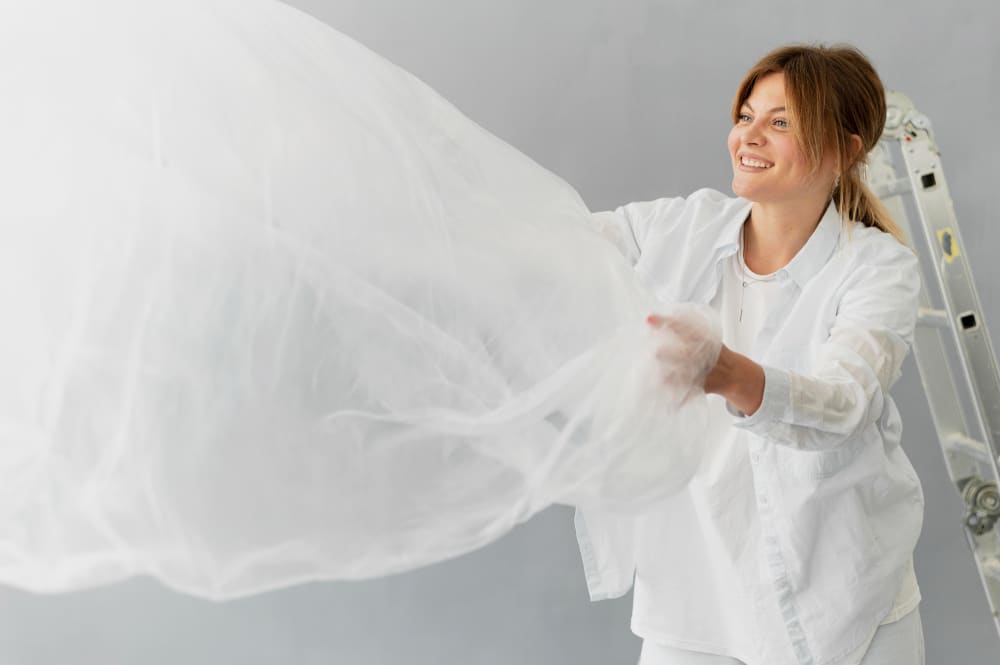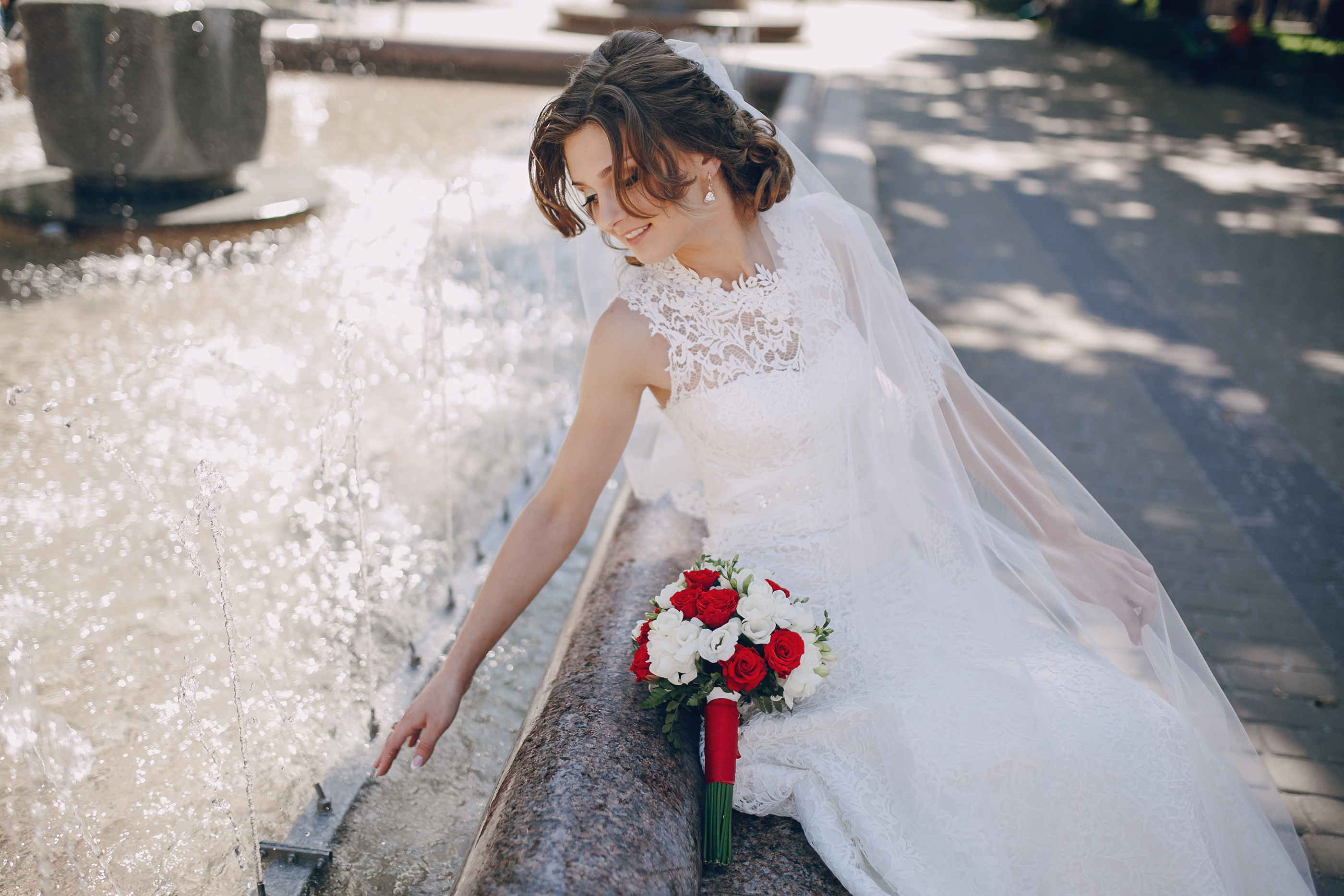Storing your wedding dress in an acid-free preservation box is one of the most critical steps to protect it from long-term damage.
Chicago’s climate—known for humid summers and fluctuating temperatures—can accelerate yellowing, mildew, and fabric deterioration if your dress is kept in a standard box or plastic garment bag. Acid-free boxes are specially designed to neutralize pH levels, preventing chemical reactions that cause fibers to weaken, discolor, or become brittle over time.
They are also breathable, allowing air circulation while shielding your gown from light, dust, and environmental pollutants.
Preserve Your Dress Without Risk
An acid-free wedding dress storage box offers the safest way to protect delicate fabrics, keeping them safe from harmful materials and poor storage conditions. Unlike regular cardboard or plastic containers, these boxes are specifically engineered to ensure chemical-free, breathable protection.
Risk-free preservation option:
- No acid or lignin to yellow or degrade the fabric
- Prevents moisture buildup, lowering the risk of mildew or mold
- Protects against light exposure that causes fading
- Maintains shape and structure when packed with acid-free tissue
- Ideal for all types of gowns, from lace to satin to beaded dresses
By eliminating the common threats to gown preservation, acid-free boxes help you avoid costly restoration later on. It’s a reliable, proven method that many Chicago bridal preservation experts strongly recommend.
What Is an Acid-Free Box?
An acid-free box is a specialized storage container made from materials that have been treated to neutralize acidity and prevent the natural breakdown of fabrics over time.
Regular cardboard and plastic boxes can contain acid, lignin, and other chemicals that slowly release into your wedding dress, causing yellowing, staining, and brittleness—especially in Chicago’s humid or fluctuating temperatures.
Acid-free boxes provide a safe, archival-quality environment, making them the gold standard for gown preservation.
Key features of an acid-free box:
- pH-neutral materials that won’t cause fabric discoloration
- Lignin-free construction to avoid long-term deterioration
- Ventilated but sealed to protect from dust and environmental pollutants
- Reinforced structure that supports the dress’s weight without warping
- Includes acid-free tissue paper for padding and folding without stress on seams
Using an acid-free box is not just about storage—it’s about preserving memories and quality for decades.
Avoid Chemical Reactions Over Time
Traditional cardboard and plastic containers often contain acids, lignin, or adhesives that slowly break down and react with fabric. Over time, this causes yellowing, weakening of the fiber, and even stains—especially harmful to delicate silks, satins, or antique lace.
1. Long-Term Impact on Fabric
When exposed to acidic materials, the fibers in your gown may become brittle and fragile, leading to irreversible damage.
2. Why Acid-Free Means Safer Fabric
Acid-free materials are chemically stable, pH-neutral, and designed to prevent such reactions, ensuring safe long-term preservation.
Sentimental or Heirloom Value
Many brides in Chicago hold on to their wedding dresses not just for style, but for deep emotional and family significance.
Whether it’s a designer gown, a custom piece, or a dress passed down through generations, improper storage can cause irreversible damage. That’s why using an acid-free wedding dress storage box is essential for preserving heirloom and sentimental gowns.
These boxes help retain the original fabric color, texture, and shape, preventing external factors such as humidity, pollution, or acid breakdown from compromising the gown’s beauty. If you hope to pass your dress to a daughter, niece, or even donate it in pristine condition, archival preservation is the only safe option.
1. Preserving Family Traditions
Whether it’s your mother’s vintage dress or your own, this method helps keep memories intact for generations.
2. Perfect for Keepsakes and Legacy
Storing in acid-free conditions makes it easier to repurpose or reuse the gown later—either in its entirety or by transforming parts into christening gowns, veils, or heirloom shadow boxes.
Prevents Mold and Mildew in Humid Conditions
Chicago’s climate brings extreme humidity in summer, which can cause mildew if the gown is packed in plastic or ordinary cardboard. Acid-free boxes often feature ventilation and breathable materials that prevent moisture retention.
1. The Problem with Plastic
Plastic traps moisture, leading to mildew and musty smells. It also lacks UV protection.
2. Breathable Storage Alternative
Acid-free boxes allow airflow while shielding the gown from humidity, making them perfect for midwestern weather shifts.

Easy Inspection Without Damage
One of the benefits of using an acid-free wedding dress box is that it makes it easy to check on your gown without risking damage.
The box opens safely without disturbing the way the dress is packed, and the acid-free tissue paper inside helps keep everything in place. Whether you want to show it to a loved one or inspect it annually, you can do so confidently—without creasing, discoloring, or exposing the gown to light or contaminants.
H3: Periodic Checkups
Inspect your gown annually to make sure no new moisture, insects, or damage has occurred.
H3: Resealing Tips
Be sure to reseal the box with fresh tissue paper, and wear clean cotton gloves when handling the fabric.
Recommended by Most Preservation Experts
Top bridal preservation professionals, as well as Chicago wedding dress cleaners, recommend acid-free storage. It’s not just a preference—it’s the industry standard for long-term dress care.
1. Trusted by Professionals
From museum curators to bridal boutique owners, acid-free methods are used to store everything from gowns to royal garments.
2. Backed by Scientific Fabric Research
Studies show pH-neutral environments reduce degradation and extend the lifespan of textiles—especially important for vintage or high-end designer dresses.
Benefits of Acid-Free Storage
Using an acid-free wedding dress box ensures:
- No fabric discoloration over time
- Prevention of mold and mildew in controlled environments
- Protection from light and air exposure
- Gentle support that avoids creasing and stretching
Chicago’s Climate Makes It a Must
Chicago’s weather brings humid summers, cold winters, and frequent temperature swings—all of which can wreak havoc on delicate wedding dress fabrics. Using an acid-free storage box helps protect your gown from moisture damage, yellowing, and mold, which are common risks in this climate. For long-term storage in the Windy City, climate-safe preservation isn’t optional—it’s essential.
Better Than Hanging Long-Term
While hanging may seem like a natural way to store your gown, it’s not ideal for long-term preservation.
Weight from the fabric can pull down over time, especially on heavy gowns, leading to distorted shapes, stretched seams, or hanger marks. An acid-free storage box allows your wedding dress to rest gently in a folded position, supported by acid-free tissue paper that cushions delicate details.
This method reduces fabric stress and maintains the gown’s original silhouette—making it a safer, more intelligent choice for Chicago brides who want to preserve their dresses for years to come.
- Prevents stretching of delicate fabrics and seams over time
- Avoids hanger marks on shoulders or straps
- Reduces the risk of shape distortion, especially in heavier gowns
- Protects embellishments like beading or lace from pulling or sagging
- Eliminates exposure to dust and sunlight, which often occurs with hanging garments
Preservation Techniques
An acid-free wedding dress storage box is designed to complement professional gown preservation methods. After your dress is cleaned, treated for stains, and wrapped in acid-free tissue, placing it in an acid-free box ensures that protection is locked in.
These boxes are breathable yet dust-resistant, ensuring the preservation process isn’t undone by external factors such as light, humidity, or pollutants. It’s the final step in keeping your dress museum-quality for decades—whether you plan to pass it down, display it, or keep it safe. It’s beneficial for storing a gown for two or more years.
Keeps Accessories Safe Too
You can also store accessories, such as veils, gloves, and belts, inside these boxes. Just make sure to use acid-free tissue paper between layers to prevent snags and wrinkles.
Common Mistakes to Avoid
- Don’t store in attics, basements, or garages
- Avoid plastic covers that can trap moisture
- Never skip the initial professional cleaning
More Information:
- Wedding Dress Cleaning and Preservation
- What to do with a 30-year-old wedding dress
- Wedding Dress Preservation
Learn More from Preservation Experts:
Want to understand more about proper dress preservation? Explore this expert guide from The Knot on storing and preserving wedding gowns for generations.
FAQs
What does acid-free mean for wedding dress boxes?
It means the box won’t release chemicals that damage fabric over time.
How long will a wedding gown last in an acid-free box?
Properly preserved dresses can last decades without fading or damage.
Can I store my veil in the same box as the dress?
Yes, just separate items with acid-free tissue paper.
Are acid-free boxes better than garment bags?
For long-term storage, yes. Boxes offer better support and protection from light and humidity.
Where can I buy acid-free wedding dress boxes in Chicago?
Check with bridal preservation services or reputable bridal boutiques for guidance.
Do I need professional help to use one?
It’s best to get your gown professionally cleaned and packed to avoid mistakes.
Can I reuse the acid-free box for another dress?
Only if it’s still in excellent condition—check for signs of wear or discoloration.
How much do they cost in Chicago?
They typically range from $50 to $150, depending on size and quality.
Will it prevent wrinkles?
It dramatically reduces wrinkling when stored correctly with tissue and padding.
What happens if I don’t use one?
Risk of yellowing, mold, or fabric breakdown increases significantly over time.





